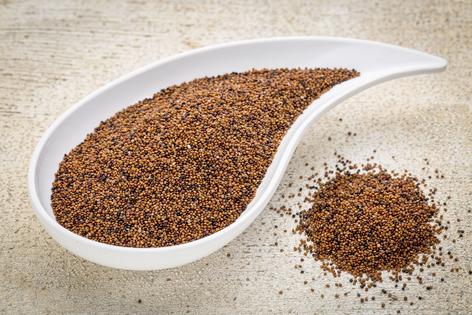Environmental Nutrition: Exploring kaniwa; Raw mushroom safety
Q: What is kaniwa, and what are its health benefits?
A: Like quinoa, kaniwa (a.k.a. canihua) is a pseudo-cereal from South America. Cultivated primarily in Peru and Bolivia, kaniwa is the seed from the flowering plant goosefoot. Kaniwa is from the same genus as quinoa (Chenopodium), but it's a different species that's about half the size, and has some different nutritional properties. Both are used similarly to grains like rice or wheat, but unlike true grains, these pseudo-cereals contain significant amounts of the amino acid lysine, kaniwa especially so. Both are nutritional powerhouses, hence their reputation as superfoods, but kaniwa, thanks to its darker, redder color, contains more flavonoids than quinoa, particularly isorhamnetin and quercetin. These phytochemicals are associated with chronic disease prevention.
Kaniwa is prepared much like other grains with a 2:1 ratio of boiling water to grain on a low simmer for about 15 minutes. Unlike quinoa, kaniwa does not need to be rinsed before preparation. A tip for cooking either is to saute the dry seed for a few minutes, until lightly browned and fragrant, before adding water. Kaniwa is excellent over salads or in place of rice in pilaf-type dishes.
--Matt Ruscigno, M.P.H., R.D.
Q: Is it safe to eat raw mushrooms?
A: White button and portobello mushrooms, found in all supermarkets, are a source of niacin, pantothenic acid, selenium, riboflavin, vitamin D, potassium and even protein. Some less common mushrooms, like shitake, are also sources of cholesterol-lowering substances, as well as other healthful compounds. In addition, mushrooms have no fat, cholesterol or sugar, and are very low in calories. Button and a few other mushroom varieties are sometimes eaten raw in dishes like salads. There's some concern, however, that eating raw mushrooms may not allow for the best digestion and absorption of nutrients. Whereas mushrooms contain substances that act as antioxidants and may protect against cancer, animal research has shown that mushrooms in their raw form may contain both carcinogenic and protective substances. However, the evidence for cancer-causing properties is not certain in humans and the amount of carcinogens in raw mushrooms, especially if eaten in moderate amounts, is very low. Cooking destroys these toxins, and even allows for better digestion. For best health, it's probably a good idea to eat mushrooms that have been cooked if you eat them often.
--Sharon Salomon, M.S, R.D.N.
(Environmental Nutrition is the award-winning independent newsletter written by nutrition experts dedicated to providing readers up-to-date, accurate information about health and nutrition in clear, concise English. For more information, visit www.environmentalnutrition.com.)







